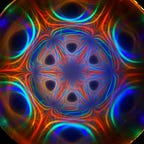Taras Shevchenko University — Spinor Field Quantization Lecture Notes
In terms of string theory, symmetry breaking usually refers to the breaking of gauge symmetries, which are mathematical transformations that do not change the physical state of the system. The Standard Model of particle physics, for instance, relies on gauge symmetries and their spontaneous breaking to explain the existence of different particle types and their properties. The Higgs mechanism, which gives particles their mass, is a well-known example of spontaneous symmetry breaking. In string theory, these gauge symmetries are expected to emerge from the properties of the strings themselves, and their breaking could similarly result in the diverse range of particles and forces we observe.
Manifold supersymmetry can be used to model particle classes as well as dimension compactification. Such models can be gratuitously interpreted as parameters for particles obeying spin-symmetry relations between fermions and bosons. Calabi-Yau manifolds are Ricci flat, meaning the Ricci curvature tensor of the manifold is zero. This property makes them suitable for models of extra dimensions in superstring theory, because it allows for a stable, compactified geometry that doesn’t contribute to the energy-momentum of the universe that would affect the value of the cosmological constant. These manifolds also have a property called SU(3) holonomy group reduction in the six-dimensional case. This property permits rigorous formulation of the complex topological structures that encode string vibration modes.
Quantizing fermions is a difficult task. Spinors are the manner in which fermions are encoded in terms of string vibration. Traditionally, in quantum mechanics, quantization is the process of finding quantum observables from classical ones. This is usually done by imposing commutation or anticommutation relations on the fields and their conjugate momenta. The classical theory of a spinor field is described by the Dirac equation. To quantize the Dirac field, we first define the canonical momentum conjugate to the field. However, for the Dirac field, the conjugate momentum does not involve time derivatives of the field, which leads to constraints in the Hamiltonian formulation of the theory. Unlike bosonic fields, which obey commutation relations, fermionic fields obey anticommutation relations due to the Pauli exclusion principle.
The quantized field can be expressed in terms of creation and annihilation operators, which add or remove particles from the state. The Fock space of states is constructed from the vacuum state by applying creation operators. Dirac quantization is a part of the general framework of quantum field theory. This framework also includes the quantization of scalar fields (which describe spin-0 particles) and vector fields (which describe spin-1 particles). However, the specifics of the quantization procedure are different for each type of field due to the different spin and statistics of the particles involved. For instance, scalar and vector fields obey algebraic commutation relations, while spinor fields obey anticommutation relations. The classical theory for scalar and vector fields are described by the Klein-Gordon and Maxwell’s equations, respectively, while the classical theory for spinor fields is described by the Dirac equation.
The fermionic fields are two-dimensional Dirac fields and are often written in terms of two-component spinors, which are complex fields that transform in a covariant manner under the Lorentz transformations of special relativity. In this more rigorous context, the symmetry transformation that relates bosons and fermions is parameterized by a spinor. This spinor is called a supersymmetry generator, and it is often denoted by the Greek letter ζ. In superstring theory, there are different types of spacetime supersymmetry depending on the number of supersymmetry generators. For instance, in Type I and Type IIB superstring theories, there is one supersymmetry generator, which leads to N=1 supersymmetry in ten dimensions. In Type IIA and heterotic superstring theories, there are two supersymmetry generators, leading to N=2 supersymmetry in ten dimensions.
The solutions of the Dirac equation are 4-component spinors, and they are manipulated using Dirac matrices. Clever use of Dirac matrices can simplify the problem significantly. For instance, in the case of the hydrogen atom, the problem can be reduced to solving two coupled radial equations instead of a 4-component equation. This approach can be combined with spinor perturbation theory or Gauss-Green methods that employ Sobolev theory to characterize existence and uniqueness of solutions. Variable separation is not relevant to the complicated potentials observed in string propagation that involves the transition of fermionic strings along worldsheets.
In superstring theory, the world-sheet, the two-dimensional surface swept out by a string as it propagates through spacetime, is described by a supersymmetric theory of topological gravity that is interdigitated with dimensional compactification but not equivalent to it. Spinor fields describe fermionic propagation along world-sheets. The relevant symmetry relates bosons (force-carrying particles) and fermions (matter particles). The existence of spacetime supersymmetry implies that for every type of boson there should be a corresponding type of fermion, and vice versa. To describe worldsheet supersymmetry in a technical way, we introduce the concept of a supermanifold. A supermanifold is a generalization of a standard manifold that includes both bosonic dimensions and fermionic dimensions.
In the context of the worldsheet, we consider a two-dimensional supermanifold, which includes one temporal dimension, one spatial dimension, and two fermionic dimensions. The action of the worldsheet theory in superstring theory is typically written in terms of a N=1 worldsheet supersymmetry. The action includes the Polyakov action for the bosonic fields (which are described by a two-dimensional metric on the worldsheet) and an action for the fermionic fields that can be combined into a single action on all fields propagating along the worldsheet.
